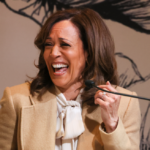Freaky Tales is set in 1987 Oakland, a fact it makes clear from its opening narration courtesy of Oakland rapper Too Short, whose raunchy ’87 track gives the film its title. And while that setting is a major part of all of its intertwined stories, its anthology structure evokes another era: the 1990s, specifically any chatty crime flick that came out in the wake of Pulp Fiction. That’s not to say Freaky Tales doesn’t have its own charms that almost make up for those too-familiar vibes.
And, this might be a nit-pick, but the first segment, “Strength in Numbers,” technically doesn’t take place in Oakland; its focal point is legendary music collective 924 Gilman, which any Bay Area music fan can tell you is in Berkeley. (I live in Oakland. Berkeley is very close, but still…) However, it’s hard to get upset when the thrust of the story is about punk kids kicking Nazi ass, as we follow Tina (Expats‘ Ji-young Yoo), Lucid (Avatar: The Way of Water‘s Jack Champion), and their friends putting aside their “no violence” ideals to fight the skinheads who’ve been targeting their hangout, as anthems of the era like “Rise Above” and “Ready to Fight” blast on the soundtrack.
After some animated enhancements and an aspect-ratio change, we move to “Don’t Fight the Feeling,” which introduces Entice (Normani) and Barbie (Ironheart‘s Dominique Thorn). They’re best friends who work at an ice-cream shop together, where they put up with a sleazy Oakland cop—Freaky Tales just refers to him as “the Guy;” he’s played by Ben Mendelsohn, reuniting with his Captain Marvel directors Anna Boden and Ryan Fleck—while sharing dreams of stardom. When they’re invited to a rap battle with Too Short (Demario “Symba” Driver plays the younger version of him, but Too Short himself pops up in one of Freaky Tales‘ many cool cameos), we see they absolutely have the talent required.
Then it’s time for “Born to Mack,” starring Pedro Pascal (The Last of Us, The Mandalorian, Fantastic Four: First Steps) as a debt collector (of the scary, bone-breaking variety) who’s decided it’s time to retire now that he’s about to become a father. However, it will come as no surprise to the viewer that there’s no easy escape from a career spent in cahoots with villains, either from one’s boss or the people you’ve wounded along the way.
Finally, we get to “The Legend of Sleepy Floyd,” which without giving anything specific away is the segment that makes Freaky Tales genre enough qualify as an io9 movie. However, there are sci-fi teases throughout. Too Short’s voice-over makes mention of a strange green glow that permeated Oakland’s atmosphere over those fateful days in 1987, and we see it zapping along through the history that Freaky Tales both recreates and fictionalizes.
That embellishment comes to the fore most in this final story. Sleepy Floyd’s remarkable real-life run with the Golden State Warriors during the 1987 NBA playoffs weaves throughout the movie as characters keep tabs on the games. That’s either because they’re fans, or because, like “the Guy” and his crew, they’re plotting to rob the players’ mansions. Things take a turn with that latter scheme, and as Freaky Tales‘ trailer spoils, the movie’s version of Sleepy Floyd (Jay Ellis) is not just a gifted ballplayer, he’s also deadly accurate with a sword.
Though some excellent gore is served up by the end, Freaky Tales‘ ultimate takeaway is a little underwhelming. The movie shines when it’s showcasing its deep love for Oakland; multiple scenes transpire outside the city’s iconic Grand Lake Theatre, and there are sly references galore, including a few to a certain local kid turned movie star (“that guy from Splash who used to sell hot dogs at A’s games”) that lead to a fantastic payoff.
Its smaller, more personal moments are also notable; among the big names, Pascal brings gravitas and a wry sense of humor to what could’ve been a one-note character, and Mendelsohn does some outstanding scenery-chewing as a powerful dirtbag.
But the inevitable last-act crossover between the stories is unfortunately not as clever or satisfying as it could have been, and its big message that “Nazis are bad”—especially in the birthplace of the Black Panthers, as Freaky Tales reminds us—is obvious enough without dialogue explicitly addressing it.
Also disappointing is that the film’s most intriguing element, a new age learning center that weaves commercials throughout the film and fuels Sleepy Floyd’s glorious revenge rampage, goes mostly unexplored—especially since it seemingly also powers Freaky Tales‘ kooky green energy field, which feels plucked from the same source as 1984’s Repo Man.
That said, if you feel nostalgia for the neon-tinged ’80s, a time of video stores, mix tapes, pay phones, and subcultures drawn together by common interests, not internet influence—and you don’t mind if a movie makes a conscious choice to lean heavy on style over substance—Freaky Tales fits the bill with energy to spare.
Freaky Tales hits theaters April 4.
Want more io9 news? Check out when to expect the latest Marvel, Star Wars, and Star Trek releases, what’s next for the DC Universe on film and TV, and everything you need to know about the future of Doctor Who.







